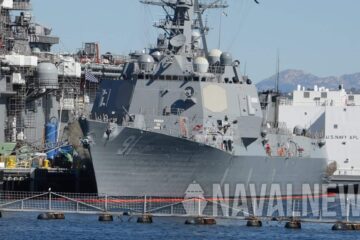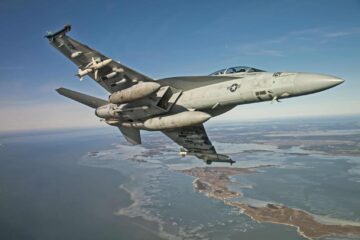A new aircraft carrier being built in Shanghai is significantly larger than the current two in service with the Chinese Navy (PLAN – People’s liberation Army Navy). Combined with the expected CATOBAR configuration, where jets are launched by a catapult and recovered using arrestor gear, it should also be able to carry heavier planes. This should further increase the potency, survivability and PLAN’s reach.
The Type-003 is, in overall terms, similar in size the the U.S. Navy’s super carriers.
The flight deck will be much larger but we will only be able to get measurements once it is constructed. However based on the dimensions of the lower hull we can say with confidence that the new carrier is, in overall terms, similar in size to the American ships. It is unlikely to be quite as large, so they will remain the largest warships of any navy. But it will be a close, at least until France builds its PANG carrier.
The above satellite image allows us to estimate its waterline length at about 300 meters (985 feet). This is slightly less than the Ford Class’ 317 meters (1,040 feet) but longer than the previous carriers. China’s Type-001 Liaoning and Type-002 Shandong carriers are about 270 meters (885 feet) long at the waterline.
The catapult take-off will be a step up in capabilities to the existing Chinese carriers. These use a short take-off but arrested recovery (STOBAR) system with a ski-jump bow. It seems likely that without a catapult fitted, the earlier two will not be able to operate the new KJ-600 plane. This airborne early warning and control (AEW&C) aircraft is China’s analogue to the E-2D Advanced Hawkeye. It promises to greatly increase the situational awareness of the carrier battle group. With this plane the Type-003 will make the PLAN one of only three navies with fixed winger carrier based AEW, joining the US Navy and Marine Nationale (French Navy).
One significant difference compared to the Ford Class is that the Type-003 is not expected to use nuclear propulsion. But it should still have a more modern propulsion system than the Soviet era steam turbines on the Liaoning and Shandong. Whether it uses advanced electric drive, known as integrated electric propulsion, remains to be seen however. While the lack of nuclear propulsion may limit its operational range, at-sea replenishment ships will travel with it to keep it topped up.

Another advanced technology often talked about with respect of the Type-003 is EMALS (electro-magnetic aircraft launch system). This takes the place of a traditional steam catapult. It is mechanically simpler and, in theory, will allow for more rapid take-offs. However the first system in the world, aboard the USS Ford, has reportedly suffered teething problems. Whether there is a surprise in store for the PLAN is hard to judge. In general the Chinese Navy do things their own way and are forging ahead, gaining valuable at-sea experience all the time.
It is not just the U.S. Navy that the Chinese carriers will be compared to. Possibly in response to the PLAN’s carrier program Japan is converting two of its current helicopter carriers to carry jets. And South Korea is also planning a carrier. Larger carriers from elsewhere may also start appearing in the region. The Royal Navy’s Queen Elizabeth class carriers are expected to operate in the Pacific.
But the closest equivalent, in terms of size and configuration, is likely to be France’s next carrier. The PANG (Porte-avions de nouvelle génération) will have a waterline length of 305 meters (1,000 feet). Its flight deck will actually be shorter however at 300 meters (984 ft). Unlike the Chinese carrier (but like the carrier it will replace, Charles de Gaulle), PANG will be nuclear powered. But they are otherwise roughly similar in size.
The assembly of the Type-003 is quite rapid now and more super-modules can be seen on the dock side in the satellite image. Soon the flight deck will start to take shape and we may get a clearer view of its final dimensions.






